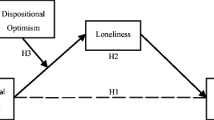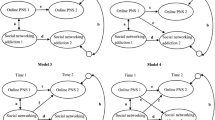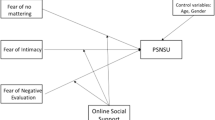Abstract
The aim of this study was to examine the effects of the two cognitive factors proposed by social cognitive theory to be highly influential on behavior (i.e., outcome expectancies and self-efficacy), in addition to optimism and loneliness, on social networking addiction among university students. In the study, 395 Chinese students (145 males, M age = 19.05, age range = 17–27 years) voluntarily completed an online, anonymous questionnaire regarding their Internet use. Almost all of the participants (99 %) were found to be using online social networking sites, and findings showed that social networking addiction was strongly correlated with Internet addiction. As hypothesized, more negative outcome expectancies and lower self-efficacy with regard to reducing Internet use were associated with higher social networking addictive tendencies. The results of the path analysis showed that low optimism was an indirect risk factor of social networking addiction through outcome expectancies and self-efficacy, while loneliness was a direct risk factor. The findings provide practical implications to preventive intervention for social networking addiction among youth.


Similar content being viewed by others
References
Akerlind, I., & Hornquist, J. O. (1992). Loneliness and alcohol abuse: A review of evidences of an interplay. Social Science and Medicine, 34(4), 405–414. doi:10.1016/0277–9536(92)90300-F
Akhtar, M., & Boniwell, I. (2010). Applying positive psychology to alcohol-misusing adolescents. Groupwork, 20(3), 6–31. doi:10.1921/095182410X576831.
Alarcon, G. M., Bowling, N. A., & Khazon, S. (2013). Great expectations: A meta-analytic examination of optimism and hope. Personality and Individual Differences, 54(7), 821–827. doi:10.1016/j.paid.2012.12.004.
Allen, J. P., Kuperminc, S. P., & Herre, K. (1994). Programmatic prevention of adolescent problem behaviors: The role of autonomy, relatedness, and volunteer service in the teen outreach program. American Journal of Community Psychology, 22, 617–638. doi:10.1007/BF02506896.
Andreassen, C. S., Torsheim, T., Brunborg, G. S., & Pallesen, S. (2012). Development of a Facebook Addiction Scale. Psychological Reports, 110(2), 501–517. doi:10.2466/02.09.18.PR0.110.2.501-517.
Ayas, T., & Horzum, M. B. (2007). Relation between depression, loneliness, self-esteem and Internet addiction. Education, 133(3), 283–291.
Bai J. (2015). Report on Weibo users development 2012 (2014年微博用户发展报告). Retrived from http://data.weibo.com/report/reportDetail?id=215. (Archived at http://www.webcitation.org/6Xl2ip13p)
Balci, Ş., & Gölcü, A. (2013). Facebook addiction among university students in Turkey: “Selcuk University example”. Journal of Turkish Studies, 34, 255–278.
Bandura, A. (1977). Self-efficacy: toward a unifying theory of behavioural change. Psychological Review, 84, 191–215.
Bandura, A. (1982). Self-efficacy mechanism in human agency. American Psychologist, 37(2), 122–147. doi:10.1037/0003-066X.37.2.122.
Bandura, A. (1986). Social Foundations of Thought and Action: A Social Cognitive Theory. In Englewood Cliffs. NJ: Prentice-Hall.
Block, J. J. (2008). Issues for DSM-V: Internet addiction. American Journal of Psychiatry, 165(3), 306–307. doi:10.1176/appi.ajp.2007.07101556.
Brislin, R. W. (1970). Back-translation for cross-cultural research. Journal of Cross-Cultural Psychology, 1(3), 185–216.
Carvajal, S. C., Clair, S. D., Nash, S. G., & Evans, R. I. (1998). Relating optimism, hope, and self-esteem to social influences in deterring substance use in adolescents. Journal of Social and Clinical Psychology, 17(4), 443–465.
Cash, H.,. D., Rae, C. H., Steel, A., & Winkler, A. (2012). Internet addiction: A brief summary of research and practice. Current Psychiatry Reviews, 8(4), 292–298. doi:10.2174/157340012803520513.
Ceyhan, A. A., & Ceyhan, E. (2008). Loneliness, depression, and computer self-efficacy as predictors of problematic Internet use. Cyberpsychology & Behavior, 11(6), 699–701. doi:10.1089/cpb.2007.0255.
Chou, C., Condron, L., & Belland, J. C. (2005). A review of the research on Internet addiction. Educational Psychology Review, 17(4), 363–388. doi:10.1007/s10648-005-8138-1.
Clayton, R. B., Osborne, R. E., Miller, B. K., & Oberle, C. D. (2013). Loneliness, anxiousness, and substance use as predictors of Facebook use. Computers in Human Behavior, 29(3), 687–693. doi:10.1016/j.chb.2012.12.002.
Conversano, C., Rotondo, A., Lensi, E., Della Vista, O., Arpone, F., & Reda, M. A. (2010). Optimism and its impact on mental and physical well-being. Clinical Practice and Epidemiology in Mental Health, 6, 25–29. doi:10.2174/1745017901006010025.
Cock, R. D., Vangeel, J., Klein, A., Minotte, P., Rosas, O., & Meerkerk, G.-J. (2014). Compulsive use of social networking sites in Belgium: Prevalence, profile, and the role of attitude toward work and school. Cyberpsychology, Behavior and Social Networking, 17(3), 166–171. doi:10.1089/cyber.2013.0029.
Davis, R. A. (2001). Cognitive-behavioral model of pathological Internet use. Computers in Human Behavior, 17(2), 187–195. doi:10.1016/S0747-5632(00)00041-8.
DeWall, C. N., & Pond, R. S. (2011). Loneliness and smoking: The costs of the desire to reconnect. Self and Identity, 10(3), 375–385. doi:10.1080/15298868.2010.524404.
Facebook (2015). Facebook Reports Fourth Quarter and Full Year 2014 Results. Retrieved from http://www.prnewswire.com/news-releases/facebook-reports-fourth-quarter-and-full-year-2014-results-300027353.html. (Archived at http://www.webcitation.org/6Xl1RKML8)
Francis, J., Eccles, M., Johnston, M., Walker, A., Grimshaw, J., Foy, R., et al. (2004). Constructing questionnaires based on the theory of planned behaviour: A manual for health services researchers. Research Based Education and Quality Improvement: Report to ReBEQI.
Gavrilov-Jerković, V., Jovanović, V., Žuljević, D., & Brdarić, D. (2013). When less is more: A short version of the Personal Optimism Scale and the Self-Efficacy Optimism Scale. Journal of Happiness Studies, 15(2), 455–474. doi:10.1007/s10902-013-9432-0.
Gillham, J., & Reivich, K. (2004). Cultivating optimism in childhood and adolescence. The Annals of the American Academy of Political and Social Science, 591(1), 146–163. doi:10.1177/0002716203260095.
Hasumi, T., Ahsan, F., Couper, C. M., Aguayo, J. L., & Jacobsen, K. H. (2012). Parental involvement and mental well-being of Indian adolescents. Indian Pediatrics, 49(11), 915–918. doi:10.1007/s13312-012-0218-y.
Hays, R. D., & DiMatteo, M. R. (1987). A short-form measure of loneliness. Journal of Personality Assessment, 51(1), 69–81. doi:10.1207/s15327752jpa5101_6.
Hormes, J. M., Kearns, B., & Timko, C. A. (2014). Craving Facebook? Behavioral addiction to online social networking and its association with emotion regulation deficits. Addiction, 109(12), 2079–2088.
Kim, J., LaRose, R., & Peng, W. (2009). Loneliness as the cause and the effect of problematic Internet use: the relationship between Internet use and psychological well-being. Cyberpsychology & Behavior, 12(4), 451–455. doi:10.1089/cpb.2008.0327.
Kittinger, R., Correia, C. J., & Irons, J. G. (2012). Relationship between Facebook use and problematic Internet use among college students. Cyberpsychology, Behavior and Social Networking, 15(6), 324–327. doi:10.1089/cyber.2010.0410.
Ko, C.-H., Liu, T.-L., Wang, P.-W., Chen, C.-S., Yen, C.-F., & Yen, J.-Y. (2014). The exacerbation of depression, hostility, and social anxiety in the course of Internet addiction among adolescents: A prospective study. Comprehensive Psychiatry, 55(6), 1377–1384. doi:10.1016/j.comppsych.2014.05.003.
Ko, C.-H., Yen, J.-Y., Yen, C.-F., Chen, C.-S., & Chen, C.-C. (2012). The association between Internet addiction and psychiatric disorder: A review of the literature. European Psychiatry, 27(1), 1–8. doi:10.1016/j.eurpsy.2010.04.011.
Krentzman, A. R. (2013). Review of the application of positive psychology to substance use, addiction, and recovery research. Psychology of Addictive Behaviors : Journal of the Society of Psychologists in Addictive Behaviors, 27(1), 151–165. doi:10.1037/a0029897.
Kraut, R., Patterson, M., Lundmark, V., Kiesler, S., Mukopadhyay, T., & Scherlis, W. (1998). Internet Paradox. American Psychologist, 53(9), 1017–1031. doi:10.1037//0003-066x.53.9.1017.
Kuss, D. J., & Griffiths, M. D. (2011). Online social networking and addiction-A review of the psychological literature. International Journal of Environmental Research and Public Health, 8, 3528–3552. doi:10.3390/ijerph8093528.
Lai, M. H. C., Wu, A. M. S., & Tong, K. K. (2015). Validation of the gambling refusal self-efficacy questionnaire for Chinese undergraduate students. Journal of Gambling Studies, 31(1), 243–256. doi:10.1007/s10899-013-9412-7.
Landers, R. N., & Lounsbury, J. W. (2006). An investigation of Big Five and narrow personality traits in relation to Internet usage. Computers in Human Behavior, 22(2), 283–293. doi:10.1016/j.chb.2004.06.001.
Levinson, A. H., Glasgow, R. E., Gaglio, B., Smith, T. L., Cahoon, J., & Marcus, A. C. (2008). Tailored behavioral support for smoking reduction: Development and pilot results of an innovative intervention. Health Education Research, 23(2), 335–346.
Li, W., O’Brien, J. E., Snyder, S. M., & Howard, M. O. (2015). Characteristics of Internet addiction/pathological Internet use in U.S. University students: A qualitative-method investigation. PloS One, 10(2), e0117372. doi:10.1371/journal.pone.0117372.
Lin, M. P., Ko, H. C., & Wu, J. Y. W. (2008). The role of positive/negative outcome expectancy and refusal self-efficacy of Internet use on Internet addiction among college students in Taiwan. Cyberpsychology & Behavior, 11(4), 451–457.
Loo, J. M., Tsai, J. S., Raylu, N., & Oei, T. P. (2014). Gratitude, hope, mindfulness and personal-growth initiative: buffers or risk factors for problem gambling? PloS One, 9(2), e83889.
Lu, X., & Yeo, K. J. (2015). Pathological Internet use among Malaysia university students: Risk factors and the role of cognitive distortion. Computers in Human Behavior, 45, 235–242. doi:10.1016/j.chb.2014.12.021.
Macau Statistics and Census Services. (2015). Yearbook of statistics 2014. Macao, China. Retrieved on 1st November 2015, from http://www.dsec.gov.mo/Statistic.aspx?NodeGuid=d45bf8ce-2b35-45d9-ab3a-ed645e8af4bb
Majer, J. M., Jason, L. A., & Olson, B. D. (2004). Optimism, abstinence self-efficacy, and self-mastery: A comparative analysis of cognitive resources. Assessment, 11(1), 57–63. doi:10.1177/1073191103257139.
Moody, E. J. (2001). Internet use and its relationship to loneliness. Cyberpsychology & Behavior, 4(3), 393–401. doi:10.1089/109493101300210303.
Morton, S., Mergler, A., & Boman, P. (2014). Managing the transition: the role of optimism and self-efficacy for first-year Australian university students. Australian Journal of Guidance and Counselling, 24(1), 90–108. doi:10.1017/jgc.2013.29.
Muthén, L. K., & Muthén, B. O. (1998–2012). Mplus user's guide (7th ed., ). Los Angeles, CA: Muthén & Muthén.
Niemz, K., Griffiths, M., & Banyard, P. (2005). Prevalence of pathological internet use among university students and correlations with self-esteem, the general health questionnaire (GHQ), and disinhibition. Cyberpsychology & Behavior, 8(6), 562–570. doi:10.1089/cpb.2005.8.562.
Padykula, N. L., & Conklin, P. (2010). The self regulation model of attachment trauma and addiction. Clinical Social Work Journal, 38(4), 351–360. doi:10.1007/s10615-009-0204-6.
Pempek, T. A., Yermolayeva, Y. A., & Calvert, S. L. (2009). College students’ social networking experiences on Facebook. Journal of Applied Developmental Psychology, 30(3), 227–238. doi:10.1016/j.appdev.2008.12.010.
Preacher, K. J., & Hayes, A. F. (2010). Asymptotic and resampling strategies for assessing and comparing indirect effects in multiple mediator models. Behavior Research Methods, 40(3), 879–891. doi:10.3758/BRM.40.3.879.
Qin, H., Rao, P.-L., & Zhong, H.-Q. (2007). A study on factors of leading to online game addiction. Chinese Journal of Clinical Psychology, 15(2), 155–156.
Ryan, R. M., & Deci, E. L. (2000). Self-determination theory and the facilitation of intrinsic motivation, social development, and well-being. American Psychologist, 55, 68–78.
Sampasa-Kanyinga, H., & Lewis, R. F. (2015). Frequent use of social networking sites is associated with poor psychological functioning among children and adolescents. Cyberpsychology, Behavior and Social Networking, 18(7), 380–385. doi:10.1089/cyber.2015.0055.
Scheier, M. F., & Carver, C. S. (1985). Optimism, coping, and health: assessment and implications of generalized outcome expectancies. Health Psychology, 4(3), 219–247.
Shaw, M., & Black, D. W. (2008). Internet addiction: definition, assessment, epidemiology and clinical management. CNS Drugs, 22(5), 353–365. doi:10.2165/00023210-200822050-00001.
Simsek, E., & Sali, J. B. (2014). The role of internet addiction and social media membership on university students’ psychological capital. Contemporary Educational Technology, 5(3), 239–256.
Van Wormer, K., & Davis, D. (2013). Addiction treatment: A strengths perspective (3rd ed.). Belmont, CA: Brooks/Cole, Cengage Learning
Wang, Y.H., Lau, J. T. F., & Wu, A. M. S. (under review). The Health Belief Model and presence of peers with Internet addiction as inter-related factors of Internet addiction among secondary school students in Hong Kong. BMC Public Health.
Wilson, K., Fornasier, S., & White, K. M. (2010). Psychological predictors of young adults’ use of social networking sites. Cyberpsychology, Behavior and Social Networking, 13(2), 173–177. doi:10.1089/cyber.2009.0094.
Wu, A. M. S., Cheung, V. I., Ku, L., & Hung, E. P. W. (2013a). Psychological risk factors of addiction to social networking sites among Chinese smartphone users. Journal of Behavioral Addictions, 2(3), 160–166. doi:10.1556/JBA.2.2013.006.
Wu, A. M. S., Lei, L. L. M., & Ku, L. (2013b). Psychological needs, purpose in life, and problem video game playing among Chinese young adults. International Journal of Psychology, 48(4), 583–590. doi:10.1080/00207594.2012.658057.
Xiao, B. S., & Wong, Y. M. (2013). Cyber-bullying among university students : an empirical investigation from the social cognitive perspective. International Journal of Business and Information, 8(1), 34–69.
Young, K. (1998). Caught in the net: How to recognize the signs of internet addiction and a winning strategy for recovery. New York: John Wiley & Sons.
Young, K. S. (2007). Cognitive behavior therapy with internet addicts: treatment outcomes and implications. Cyberpsychology & Behavior, 10(5), 671–679. doi:10.1089/cpb.2007.9971.
Young, K. S. (2013). Treatment outcomes using CBT-IA with internet-addicted patients. Journal of Behavioral Addictions, 2(4), 209–215. doi:10.1556/JBA.2.2013.4.3.
Yuan, L. (1997). Measures of personality and social psychological attitudes, Chinese translation. Taipei, Taiwan: Academic Press (In Chinese).
Author information
Authors and Affiliations
Corresponding author
Ethics declarations
Conflict of Interest
All authors declare that they have no conflict of interest.
Rights and permissions
About this article
Cite this article
Yu, S., Wu, A.M.S. & Pesigan, I.J.A. Cognitive and Psychosocial Health Risk Factors of Social Networking Addiction. Int J Ment Health Addiction 14, 550–564 (2016). https://doi.org/10.1007/s11469-015-9612-8
Published:
Issue Date:
DOI: https://doi.org/10.1007/s11469-015-9612-8




